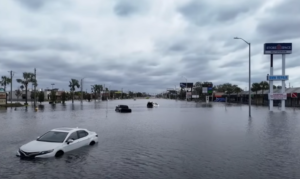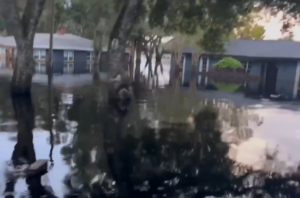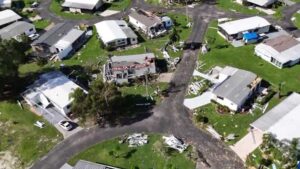Flooding persists one month later, FEMA worker fired

Cars stranded in flood waters along Tampa’s Fowler Avenue after Hurricane Milton, October 10, 2024
According to the latest satellite image analysis from ICEYE, the flood damage from last month’s Hurricane Milton may be far more extensive than initially thought. While Hurricane Helene’s flood damage was clear from the onset, affecting 165,330 buildings across seven states per ICEYE and claiming at least 230 lives, many did not suspect the same to come from Milton, which was largely viewed as a wind event, killing at least 17 people. However, according to the analysis, Milton has now surpassed the total number of affected structures from Helene, leaving Florida devastated from back-to-back storms with barely any time to recuperate before floodwater inundated the streets once again.
The satellite image firm reports more than 185,000 buildings in Florida were affected by the rising water from Milton, including eastern and inland parts of the state – the report observing “storm surge from Bradenton southward to Naples, and 10-15 inches of rainfall from St. Petersburg through Orlando.” Analyzing over 100 satellite images, ICEYE concluded the counties with the worst damage were Hernando, Volusia, Orange, Broward and Highlands – also noting that over 74,000 structures in Hillsborough were affected. Some 13,000 of these structures had more than five feet of water or storm surge, adding to the costly grand totals. Now the recovery process is two-fold, with several cities and towns down the West Coast of Florida seeing millions in cleanup costs from the follow-up storm, and crippled infrastructure and housing underneath the piles of wreckage.

Flooding from Hurricane Milton persists in this Ridge Manor, Florida neighborhood, November 6, 2024. Courtesy, WTVT-TV
One month after Milton’s October 9 landfall, the small town of Ridge Manor, in eastern Hernando County north of Tampa, is still dealing with over five feet of flooding after Milton caused an engorged Withlacoochee River to spill into local homes and buildings. New Port Richey is facing over $3 million in cleanup work including debris removal, and in Indian Rocks Beach in Pinellas County, the bill hit $1.5 million.

Hurricane Milton tornado damage in North Fort Myers, October 9, 2024. Courtesy, WBBH-TV
Further south, Milton caused a whopping $280 million worth of damage to residential and commercial structures in Collier County, where county staff worked day and night to house almost 3,000 displaced residents. Much of Southwest Florida is still assessing and calculating the damage from the storm, as local governments try to estimate the total costs to rebuild.
While recovery continues, FEMA announced this past weekend that it has fired one of its Florida disaster relief workers for directing those on her field team to skip surveying homes with yard signs supporting President-elect Trump. The Daily Wire reports the supervisor and her team were assigned to go door-to-door in Highlands County. Governor DeSantis has ordered the Florida Division of Emergency Management to investigate whether this happened in other Florida counties as well.
Many housing markets have begun to adjust to the disaster, as double storm damaged homes are being listed across Tampa Bay, something economists say will weaken the market – where home sales are down 17% year over year. While the effects of the back-to-back hurricanes will continue to ripple across Florida’s markets and industries, many regional banks have braced themselves for loan defaults that come with the devastation of major storms. Analysts have suggested that many lenders may provide lower interest rates, deferred payments and other concessions to try to ease the financial hardship in one of Florida’s most expensive disasters to date and help the Sunshine State get back on its feet.
LMA Newsletter of 11-12-24

